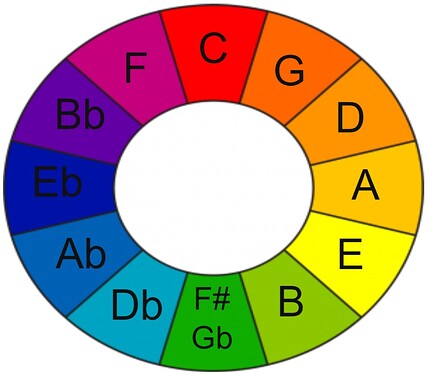The Circle of Fifths Part 1 - where does it come from?
I recently added a topic - a journey and exploration into the dark and mysterious world of modes – in which I used the circle of fifths to find modes in parallel.
Writing that topic gave me inspiration to write this new topic devoted to the circle of fifths itself.
What is it?
Where does it come from?
How and why can it be used?
Where does it lead?
We will begin Part 1 with a quite lengthy and, hopefully, a clear and fascinating discovery of a way to consider the origins and creation of the Circle of Fifths. The ‘where does it come from’ part.
ps
Justin’s lessons refer to it as the Cycle of 5ths: The Cycle Of 5ths & The Cycle Of 5ths In Practice
Let us start by taking a look at this glorious tool / work of art / natural phenomenon.
Here it is in beautiful colour (I have overlaid a colour wheel on to the circle).
The Circle of Fifths
There are several points to notice and discuss immediately.
- The letters represent musical notes.
- Like a clock face, there are twelve positions.
- The letter / note C stands at the 12 o’ clock position by convention.
- The letters do not follow in alphabetical order – alphabetical order is not a relevant concept within and around the circle itself.
- Only one pair of enharmonic equivalent notes are shown (F# and Gb at the six o’ clock position). This is my conscious selection. Other enharmonic equivalents do exist and can be used depending on context.
